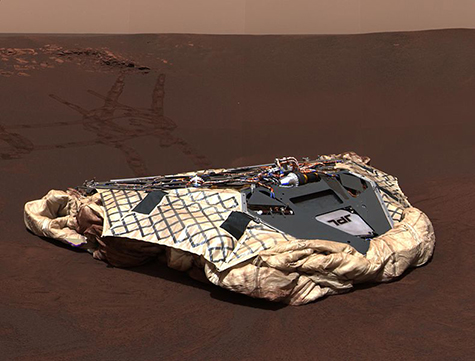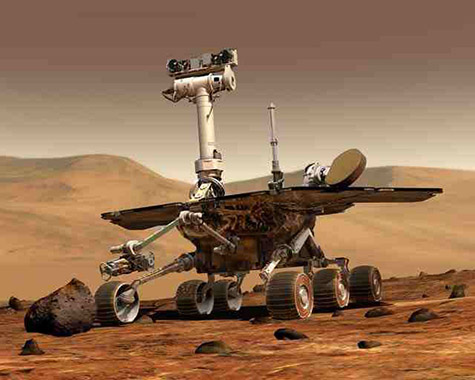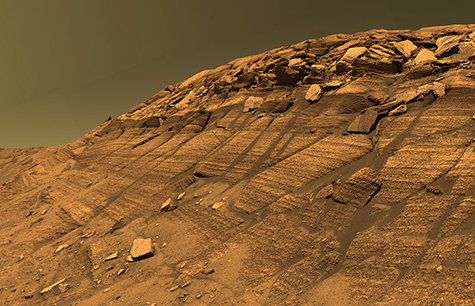
Ten years ago, on Jan. 24, 2004, the Opportunity rover landed on a flat plain in the southern highlands of the planet Mars and rolled into an impact crater scientists didn’t even know existed. The mission team, understandable giddy that it hadn’t crashed or mysteriously gone silent during the descent (as other Mars missions have done) called it “a hole in one.”
In honor of the rover’s 10th anniversary, Ray Arvidson, PhD, deputy principal investigator of the dual-rover mission, recently took an audience at Washington University in St. Louis on a whirlwind tour of the past decade’s exploration of Mars, cheered on by students holding signs reading “Boffins.” (“Boffin” is British slang for “scientist.”)
Introducing Arvidson, Bill McKinnon, PhD, a fellow WUSTL planetary scientist, said Arvidson had done graduate work under Tim Mutch of Brown University, who led the Lander Imaging Team for the Viking mission to Mars.
When Mutch stepped down as team leader in 1977, Arvidson took over for him. Arvidson, the James S. McDonnelll Distinguished University Professor in Arts & Sciences, has been involved in every significant U.S. interplanetary mission to Mars and Venus since then, McKinnon said.
Arvidson had a good story to tell. The 10-year-old rover, dirty and arthritic though it may be, just found evidence of conditions that would support the chemistry of life in the planet’s past, work that earned it a spot in the Jan. 24 issue of Science magazine, just in time for Opportunity’s anniversary.

Why are we on Mars?
“We’re exploring Mars to better understand Earth,” Arvidson said. “On Mars, we can learn about geological processes and environmental processes — maybe habitability, maybe life, that remains to be seen — for a period of time that’s lost on Earth.
“Mars preserves the whole geologic record,” he said, “because there’s so little erosion there. We have the whole stratigraphic section; minerals are well preserved. So by touring and exploring Mars, we can travel back into early geologic time.
“The punch line is that the farther back we look in the rock record, the more we find evidence of the interaction of relatively mild waters with the Martian crust. And the farther back we look, the better the chemical conditions for life.
“Today, Mars is dry and cold. But in the past, there were exploding volcanoes with hydrothermal vents, there were fumaroles (steam-charged vents), there were rivers, there were dendritic streams, there were lakes.
“The older you look, the better it gets in terms of warm and wet,” Arvidson said.

The MER rovers
“The rovers are really field geologists,” Arvidson said. “They’re robotically driven, but they’re doing what we would be doing if we had boots on Mars with rock hammers, collection bags, microscopes and little huts where we could do some chemical analyses.
“What people don’t realize is that on any given day, in the afternoon Mars time, when the data come down through the Deep Space Net, we get just 100 to 200 megabits. That’s a soda straw, not a fire hose. So we have to be really careful about what we command and prioritize what we acquire.
“But operating at 100 to 200 megabits per sol, we’ve attempted to reconstruct the past environment from the geologic record just as a field geologist would do. (Sols, or Martian days, are 39 minutes longer than Earth days.)
“We lost Spirit, Opportunity’s twin, back in 2010,” Arvidson said. Stuck in the sand, it was unable to point its solar arrays in the correct direction to survive winter, and it went quiet March 22, 2010, or sol 2,210.
But Arvidson is not complaining; the rovers were expected to survive only about 90 to 180 sols. “They were supposed to last three or six months and it’s been 10 years,” he said. “They were supposed to drive maybe a thousand meters, and Opportunity is now about to break 40,000 meters.”
NASA celebrates milestone
Ray Arvidson participated in a NASA celebration of Opportunity’s 10th anniversary on Jan. 23. To watch the webcast of the program, visit here.
To follow congratulatory messages on Twitter, search for #10YrsOnMars.
To hear a Science podcast in which Arvidson describes Opportunity’s latest discovery, visit here.
It is true that time has taken its toll. “In rover years, Opportunity’s about 300 years old,” Arvidson joked.
The solar panels are still generating power, but they’re dusty, so they’re operating at only 60 percent efficiency. The robotic arm is arthritic. It can move up and down but not side to side. Two mineral-detecting instruments are no longer operative, and the rover has been driving backward for years because the actuator that turns the right front wheel azimuthally to steer in place is jammed.
But old and arthritic though it may be, the plucky rover is still scoring discoveries significant enough to make it into the pages of Science.
Crater-hopping on Mars
Early in its mission, although already past its expiry date (on sol 134), Opportunity drove into a 430-foot-wide crater named Endurance. It spent the next half-year exploring sedimentary layers exposed in the crater wall.
They were named the Burns formation for Roger Burns, a geologist who predicted the importance of sulfate mineralogy on Mars based on results obtained by the Viking missions and his laboratory analyses.
“The formation consists of many thin layers of sulfate sandstone that formed in ancient lakebeds, were reworked into sand dunes by the wind, and then recemented into rock by rising groundwater,” Arvidson said.
Looking at the chemistry of the rocks, the mission scientists inferred that they had formed under acidic and oxidizing conditions. The rover, they quipped, had discovered evidence not of water but of acid on Mars.

At Cape York, the rover ground into a rock called Espérance. The deeper it ground, the more the rock’s composition resembled that of an aluminum-rich clay called montmorillonite.
“To make an aluminum-rich clay,” Arvidson explained, “you have to leach many other elements out of the rock, such as iron and magnesium. So this is a place a lot of water flowed through, probably because fracturing made the rock very permeable.
“If you go through the chemistry and infer characteristics of the water, it was mildly acidic at best and reducing, not oxidizing, and those are habitable conditions. We think this kind of environment existed many places on Mars,” he said.
What happened to Mars?
But if Mars was once warm and wet, what happened to turn it cold and dry?
“Early Mars was volcanically active,” Arvidson said. “The volcanoes would have pumped greenhouse gases into the atmosphere that warmed the planet. It also had an internal magnetic field that deflected the solar wind, preventing it from stripping away the atmosphere. But as the core of the planet froze, its magnetic field diminished, the solar wind scoured away the atmosphere, and without a dense atmosphere, it became the cold, dry planet we know today.
“That’s what the geologists think,” he said. “So we’re convincing the atmosphere modelers to give us enough greenhouse oomph, with whatever gas they want, in order to get up to temperature where there would be liquid water on the surface. Because the geological evidence says, ‘That’s a fact, Jack.’”
The Boffins-in-training all stood and cheered.